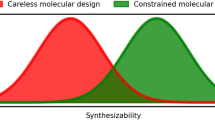Abstract
The design of molecules with desired properties is still a challenge because of the largely unpredictable end results. Computational methods can be used to assist and speed up this process. In particular, genetic algorithms have proved to be powerful tools with a wide range of applications, e.g. in the field of drug development. Here, we propose a new genetic algorithm that has been tailored to meet the demands of de novo drug design, i.e. efficient optimization based on small training sets that are analyzed in only a small number of design cycles. The efficiency of the design algorithm was demonstrated in the context of several different applications. First, RNA molecules were optimized with respect to folding energy. Second, a spinglass was optimized as a model system for the optimization of multiletter alphabet biopolymers such as peptides. Finally, the feasibility of the computer-assisted molecular design approach was demonstrated for the de novo construction of peptidic thrombin inhibitors using an iterative process of 4 design cycles of computer-guided optimization. Synthesis and experimental fitness determination of only 600 different compounds from a virtual library of more than 1017 molecules was necessary to achieve this goal.
Similar content being viewed by others
References
Maddalena, D. J., Exp. Opin. Ther. Patents, 8 (1998) 249-258.
Holland, J. H., Adaptation in natural and artificial systems, MIT Press, Cambridge, MA, 1992.
Goldberg, D. E., Genetic Algorithms in Search, Optimization, andMachine Learning, Addison-Wesley Publishing Company, Inc., Reading, Massachusetts, 1989.
Terfloth, L. and Gasteiger, J., Drug Discovery Today, 6 (2001) S102-S108.
Glen, R. C. and Payne, A.W. R., J. Comp.-Aided Mol. Design, 9 (1995) 181-202.
Devillers, J. J., Chem. Inf. Comput. Sci., 36 (1996) 1061-1066.
So, S.-S. and Karplus, M. J., Med. Chem., 39 (1996) 1521-1530.
Tomandl, D., Schober, A. and Schwienhorst, A., J. Comp.-Aided Mol. Design, 11 (1997) 29-38.
Pohlheim, H. 1998, GEATbx: Genetic and Evolutionary Algorithm Toolbox for use with MATLAB Version 1.92. [http://www.geatbx.com/docu/algindex.html]
Illgen, K., Enderle, T., Broger, C. and Weber, L., Chem. Biol., 7 (2000) 433-441.
Weber, L., Wallbaum, S., Broger, C. and Gubernator, K., Angew. Chem., 107 (1995) 2452-2454.
Hofacker, I. L., Fontana, W. and Stadler, P. F., Monatshefte Chem., 125 (1994) 167-188.
Zuker, M., Nucl. Ac. Res., 9 (1981) 133-148.
Matthysse, S., Neurochem. Res., 16 (1991) 397-408.
Lin, C. Y., Hu, C. K. and Hansmann, U. H., Phys. Rev. E, 64 (2001) 052903.
Frank, R., Tetrahedron, 48 (1992) 9217-9232.
Bray, A. M., Maeji, N. J. and Geysen, H. M., Tetrahedron Lett., 31 (1990) 5811-5814.
Wirsching, F., Opitz, T., Dietrich, R. and Schwienhorst, A., Gene, 204 (1997) 177-184.
Berg, M. Methodenentwicklung und Etablierung von Fluoreszenzassays zur Wirkstoffsuche im 1536-Well Format, Universität Karlsruhe, Karlsruhe, 1998.
Lipinski, C. A., Lombardo, F., Dominy, B. W. and Feeney, P. J., Adv. Drug Delivery Rev., 23 (1997) 3-25.
Claeson, G., Blood Coag. Fibrinol., 5 (1994) 411-436.
Hauptmann, J. and Stürzebecher, J., Thrombosis Res., 93 (1999) 203-241.
Schneider, G. and Wrede, P., Biophys. J., 66 (1994) 335-344.
Eigen, M., Die Naturwissenschaften, 58 (1971) 465-523.
Eigen, M. and Schuster, P., Die Naturwissenschaften, 64 (1977) 541-565.
Barnett, L. J., Theor. Biol., subm. (2000).
Ochoa, G. and Harvey, I., In Banzhaf, W. and Reeves, C. (eds),Foundations of Genetic Algorithms, vol. 5. Morgan Kaufmann, San Francisco, 1999, pp. 245-264.
Douget, D., Thoreau, E. and Grassy, G. J., Comp.-Aid. Mol. Design, 14 (2000) 449-466.
Westhead, D. R., Clark, D. E., Frenkel, D., Li, J., Murray, C. W., Robson, B. and Waszkowycz, B., J. Comp.-Aid. Mol. Design, 9 (1995) 139-148.
Schneider, G., Lee, M.-L., Stahl, M., Schneider, P. J., Comp.-Aid. Mol. Design, 14 (2000) 487-494.
Author information
Authors and Affiliations
Corresponding author
Additional information
These authors contributed equally to the results presented
These authors contributed equally to the results presented
These authors contributed equally to the results presented
These authors contributed equally to the results presented
Rights and permissions
About this article
Cite this article
Kamphausen, S., Höltge, N., Wirsching, F. et al. Genetic algorithm for the design of molecules with desired properties. J Comput Aided Mol Des 16, 551–567 (2002). https://doi.org/10.1023/A:1021928016359
Issue Date:
DOI: https://doi.org/10.1023/A:1021928016359




